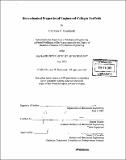Biomechanical properties of engineered collagen scaffolds
Author(s)
Bonebreak, Christina M. (Christina Michelle)
DownloadFull printable version (2.086Mb)
Other Contributors
Massachusetts Institute of Technology. Dept. of Mechanical Engineering.
Advisor
Simona Socrate.
Terms of use
Metadata
Show full item recordAbstract
An experiment was performed to determine the effect of crosslinking on the stiffness of collagen scaffolds. Engineered non-crosslinked and dehydrothermally crosslinked chondroitin-6-sulfate collagen scaffolds were hydrated and loaded in tension, and their mechanical properties were compared. It was found that non-crosslinked scaffolds experience an average increase in weight after hydration of 10,353%, compared to 7,265% for crosslinked scaffolds. Hyperelastic material parameters were determined by the Arruda-Boyce eight-chain model, which was fit to the experimental data. This model predicted an average number of rigid links per collagen fiber of 1.3 and 1.21 for crosslinked and non-crosslinked scaffolds, respectively. Additionally, the collagen fiber densities were found to be 2.92 x 1017 for crosslinked networks and 1.68 x 1017 for non-crosslinked networks. These results can be applied to the changes that take place in the cervix at the onset of delivery. It is hypothesized that the crosslinking between collagen fibers in the cervix breaks down during preparation for delivery, allowing more fluid to enter the extracellular matrix and weaken the tissue. By performing tension tests on cervix tissue in vivo, one can produce a theoretical fit to predict relevant collagen network parameters, which can be compared with those of non-pregnant cervical tissue to indicate the early onset of cervical ripening. (cont.) By being able to quantitatively assess a woman's risk of early cervical ripening, it may be possible to prevent premature births associated with cervical insufficiency.
Description
Thesis (S.B.)--Massachusetts Institute of Technology, Dept. of Mechanical Engineering, 2005. Includes bibliographical references (leaves 33-35).
Date issued
2005Department
Massachusetts Institute of Technology. Department of Mechanical EngineeringPublisher
Massachusetts Institute of Technology
Keywords
Mechanical Engineering.